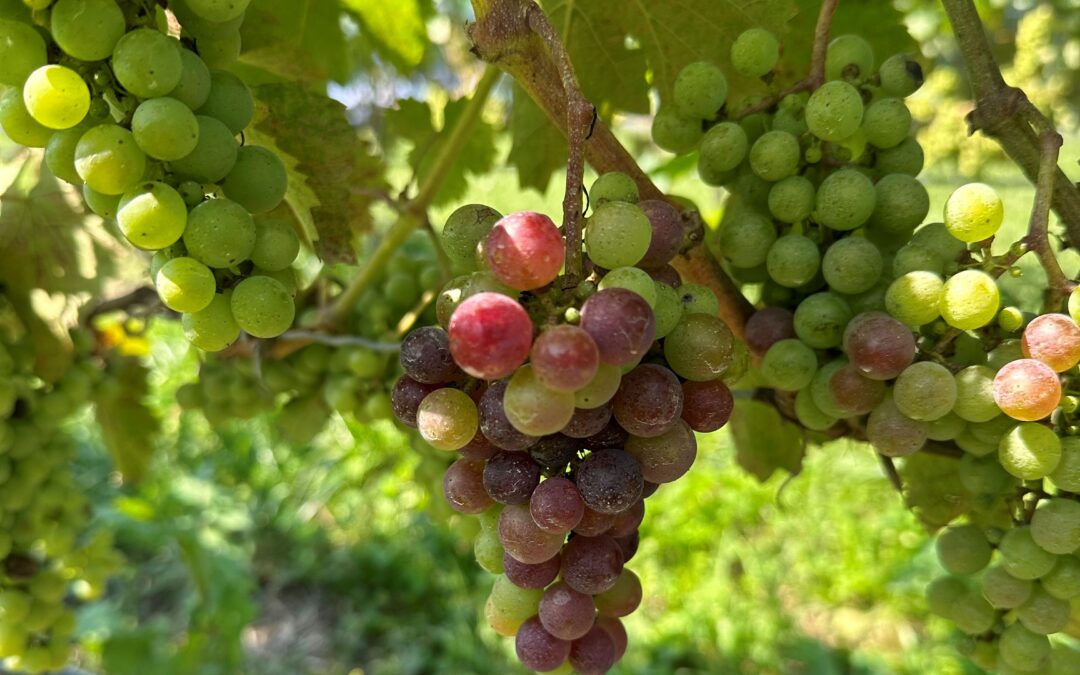In the vineyard, we are starting to see veraison. That is the time that grapes turn colour, from green to red or green to golden. That is also the time that the sugars the leaves are producing start to load into the grapes. Before veraison, all the energy produced by the plant goes into vegetative growth, but after, the energy goes into reproductive growth. In case you’re wondering, we’re about 10 days behind last year.
We aren’t the only ones that notice veraison. Over the past couple of weeks, we have seen clouds of malevolent starlings start to gather, almost like that Alfred Hitchcock movie. Visitors to Niagara have started to notice the bird bangers. Our neighbours grow some very early ripening varieties, so their bangers started a couple of weeks ago. With every loud bang, we could see a cloud of birds take off from their fields and move to ours, so I know the bangers work.
While we do use a couple of cannons, we also uses bird nets. These are brought down from the top canopy wire where the are stored down to the fruiting zone. While they protect the grapes from birds, the nets can cause problems with the drying air flow, so before we bring them down, we have to clean up the area where the fruit will mature.
To clean up the area, we begin by removing all the leaves in the fruiting area. These leaves were some of the earliest to emerge this year, so they are starting to die back. Each leaf of a plant only lasts so long, and as they start to die, the plant tries to remove as many nutrients as possible. This is why leaves turn colour and fall off in autumn. Unlike the leaves of a maple tree that all emerge at the same time, grapevines produce leaves all summer as the vine grows. That means that the leaves at the base of the vines are the oldest, while those at the top are the youngest. The base of the vines is also where the fruit is.
Once we get the leaves cleaned up, we look at the fruit. Any damaged clusters, for instance, caused by hail or insects, must be removed, or we risk disease. Next we have to look at the quantity of fruit on each vine. If there are too many clusters, we remove some. This ‘green harvest’ ensures top quality fruit. If we leave too many grapes on a vine, the flavour of the juice won’t be as intense, and the grapes may struggle to ripen in our cool October. Then, the nets come down and the grapes are safe for the next 6 to 8 weeks till harvest. We have about 75 kilometers of rows and nets on both sides of the vine, which makes this a lot of necessary work.
One acre of clean up and net placement take about 25 man hours. In addition, in some blocks we may be dropping (cutting away) around 1/2 to 1 tonne per acre, which we could use to make another 40 to 80 cases of wine. Sounds crazy, but this is a critical step.
Our decision to farm organically and biodynamically leaves us much less of a safety net if mildew or fungus take hold – and this can happen if we get a couple of extra days of rain. The extra space between clusters allows the grapes to dry, reducing the risk.
Moreover, we want the best not the most. We could decide that a little disease is okay, a little underripe is all right, that good enough is good enough, but that’s not Southbrook.
The reputation of a wine region is based on how good it can be. I want Ontario to be admired for its winemaking – worldwide. I want no compromise – I can’t do what I do and be the least expensive, but I can be among the best.

